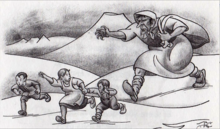Type a search term to find related articles by LIMS subject matter experts gathered from the most trusted and dynamic collaboration tools in the laboratory informatics industry.

In Icelandic folklore, Grýla is a monstrous entity who lives in the wilderness of Iceland. The name Grýla is first attested in medieval sources. However, the earliest unambiguous references to Grýla's gender and her association with Christmas date only from the seventeenth century. In seventeenth-century poems about Grýla, she is generally represented as a hideous and greedy ogress who wanders between human settlements and demands charity from those she encounters, often asking for naughty children. Modern depictions of Grýla tend to focus more strongly on her role as the mother of the Yule Lads (Icelandic: jólasveinar). Today, the most monstrous aspects of her character and appearance (such as her appetite for children) are generally toned down for younger audiences.
The name Grýla appears in a list of heiti for troll-women in the Prose Edda, composed in the 13th century by Icelandic skald Snorri Sturluson.[1] However, a list of Grýlu heiti ('heiti for Grýla') in one manuscript of the Prose Edda from the early 14th century, AM 748 I b 4to, gives various terms for foxes, suggesting an association with the Arctic fox.
Several parallels to Grýla exist in the North Atlantic region, and these are generally associated with mumming and disguise traditions. Terry Gunnell hypothesizes that Grýla may once have been associated with similar disguise traditions in Iceland, although such practices have not survived to the present day.[2] In contrast to later depictions of Grýla, no explicit mention is made of Grýla's gender. Not all counterparts to Grýla identified by Gunnell are female figures, and it is possible that Grýla was originally conceived of as a male monster rather than an ogress.[3] In one seventeenth-century poem about Grýla, which depicts her as wandering between farms in summer rather than at Christmas, she is described as a hermaphrodite.[4]
Grýla is closely associated with Christmas folklore in younger traditions.[2] The oldest extant source connecting Grýla with Christmas is a poem that was likely co-composed by the Rev. Guðmundur Erlendsson of Fell in Sléttuhlíð and his brother-in-law Ásgrímur Magnússon, who was a farmer and rímur-poet. This poem, "Grýlukvæði", can be dated to c. 1638–1644.[5] Several years after this, in c. 1648–1649, the Rev. Hallgrímur Pétursson composed a poem, "Leppalúðakvæði", in which Grýla's lazy and unpleasant husband, Leppalúði, makes his appearance and claims that Grýla was left bedridden after her journey to Sléttuhlíð.[6]